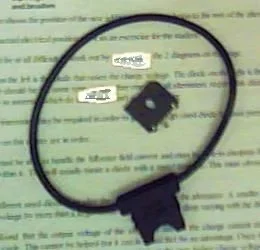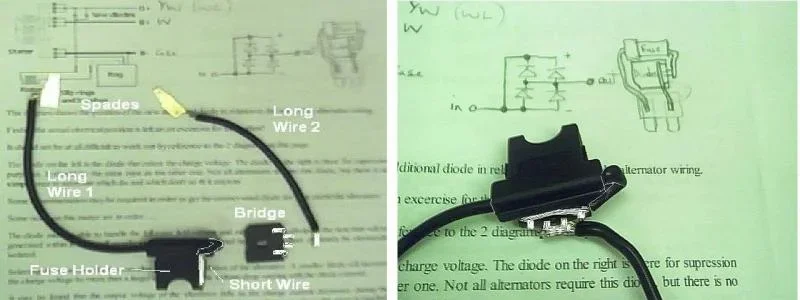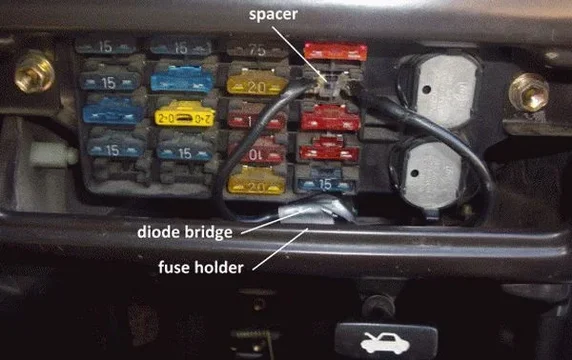This modification applies to most vehicle built before about 1990 (and quite a few after), but as I have a HJ60 I'm posting it here.
Vehicles built after 1990 have different electrical demands to older ones. They need less raw cranking power to start them, but must provide lots of ‘fill-in’ reserve power to ensure the proliferation of additional electrical devices fitted don’t suffer from ‘brown-out’ as different loads switch on and off. To accommodate these changed needs battery manufacturers and car makers have quietly made small alterations to battery chemistry and alternator regulator settings. Older vehicles will benefit from having their voltage regulator output better matched to the batteries available today, in particular they will achieve a longer battery life. (All figures quoted are @ 20°C)
Old style Voltage Regulators use an electromagnet balanced against a spring to turn off/on power to the field coil in an alternator. Changing the spring tension or the contact spacing will change the voltage for the off/on balance point. Any auto electrician can easily adjust these regulators by carefully bending the arm that supports the regulating contacts (axial alignment and parallel surfaces must be maintained). 14.0V to 14.5V is what you need (depending on the type of battery fitted).
<Edit> Toyota currently specifies 14.5V +-0.6V, see here - http://www.autoshop101.com/forms/elec05.pdf <Edit>

Electronic style Voltage Regulators are often sealed units with no internal adjustment possible. But they are easy to trick into regulating at a different voltage by changing the sense voltage that is input to them. The easiest way to increase an electronic Voltage Regulator’s output is to add a diode between the battery positive and the regulator sense input. This reduces the voltage sensed at the regulator by 0.6V, so the electronic Voltage Regulator will increase the output by the same amount in order to get its sense voltage back up to the ‘correct’ value. 13.8V + 0.6V = 14.4V. This is right at the correct charging level for modern batteries while remaining below the water loss voltage.
Most Electronic Voltage Regulators have 2 fuses, the ‘Charge’ or ‘Lamp’ fuse provides the sense voltage directly to the regulator while the ‘Engine’ fuse provides battery power to the Field Coil during and just after start-up when almost all of the alternator’s output is replentishing the battery. Note in the diagram below that the voltage from the ‘Engine’ fuse goes to the ‘IG’ input then through a diode and an ISOLATING resistor before joining the voltage from the ‘Charge’ fuse.
Check your vehicle’s electrical circuit diagram to see if your vehicle has separate fuses for the ‘IG’ and ‘L’ inputs and that there is an isolating resistor on the ‘IG’ input. The diode trick won’t work without the isolation.

The Alternator Regulator Voltage Booster Modification is easy to apply to many older vehicles that have electronic regulators. In most vehicles the ‘Charge’ fuse for the alternator can be replaced with a diode/fuse combination (see diagram) to accomplish the modification without having to alter any wiring. This has the additional advantage of being able to be changed back at any time. You can buy this device on ebay for about $35 or build it yourself for less than $10.

See how to build it in part 2



Vehicles built after 1990 have different electrical demands to older ones. They need less raw cranking power to start them, but must provide lots of ‘fill-in’ reserve power to ensure the proliferation of additional electrical devices fitted don’t suffer from ‘brown-out’ as different loads switch on and off. To accommodate these changed needs battery manufacturers and car makers have quietly made small alterations to battery chemistry and alternator regulator settings. Older vehicles will benefit from having their voltage regulator output better matched to the batteries available today, in particular they will achieve a longer battery life. (All figures quoted are @ 20°C)
Old style Voltage Regulators use an electromagnet balanced against a spring to turn off/on power to the field coil in an alternator. Changing the spring tension or the contact spacing will change the voltage for the off/on balance point. Any auto electrician can easily adjust these regulators by carefully bending the arm that supports the regulating contacts (axial alignment and parallel surfaces must be maintained). 14.0V to 14.5V is what you need (depending on the type of battery fitted).
<Edit> Toyota currently specifies 14.5V +-0.6V, see here - http://www.autoshop101.com/forms/elec05.pdf <Edit>
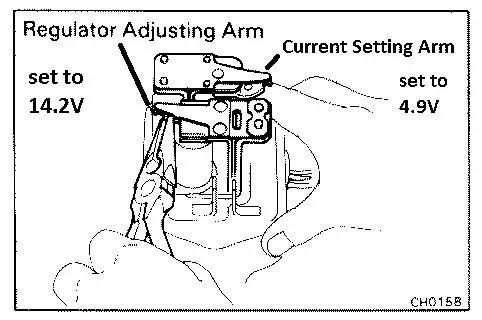
Electronic style Voltage Regulators are often sealed units with no internal adjustment possible. But they are easy to trick into regulating at a different voltage by changing the sense voltage that is input to them. The easiest way to increase an electronic Voltage Regulator’s output is to add a diode between the battery positive and the regulator sense input. This reduces the voltage sensed at the regulator by 0.6V, so the electronic Voltage Regulator will increase the output by the same amount in order to get its sense voltage back up to the ‘correct’ value. 13.8V + 0.6V = 14.4V. This is right at the correct charging level for modern batteries while remaining below the water loss voltage.
Most Electronic Voltage Regulators have 2 fuses, the ‘Charge’ or ‘Lamp’ fuse provides the sense voltage directly to the regulator while the ‘Engine’ fuse provides battery power to the Field Coil during and just after start-up when almost all of the alternator’s output is replentishing the battery. Note in the diagram below that the voltage from the ‘Engine’ fuse goes to the ‘IG’ input then through a diode and an ISOLATING resistor before joining the voltage from the ‘Charge’ fuse.
Check your vehicle’s electrical circuit diagram to see if your vehicle has separate fuses for the ‘IG’ and ‘L’ inputs and that there is an isolating resistor on the ‘IG’ input. The diode trick won’t work without the isolation.

The Alternator Regulator Voltage Booster Modification is easy to apply to many older vehicles that have electronic regulators. In most vehicles the ‘Charge’ fuse for the alternator can be replaced with a diode/fuse combination (see diagram) to accomplish the modification without having to alter any wiring. This has the additional advantage of being able to be changed back at any time. You can buy this device on ebay for about $35 or build it yourself for less than $10.
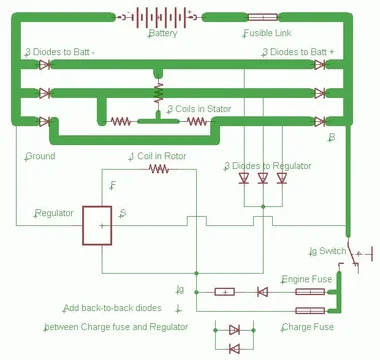
See how to build it in part 2
Last edited:

